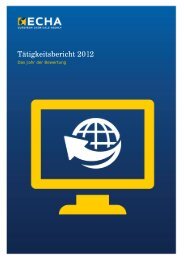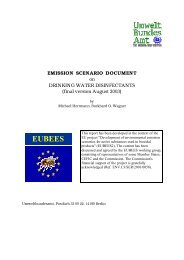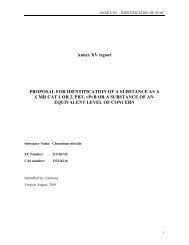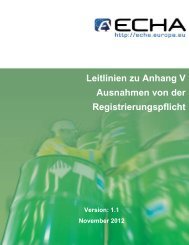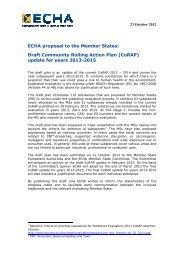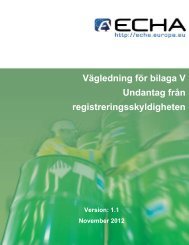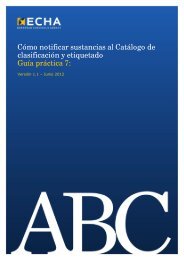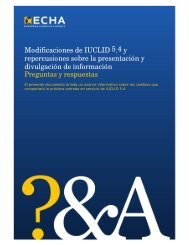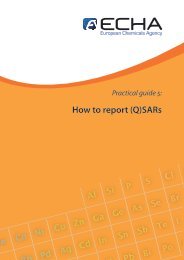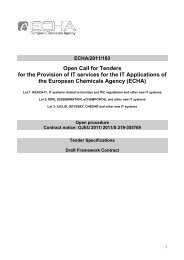Strategy For Limiting Risks Human Health Draft of ... - ECHA - Europa
Strategy For Limiting Risks Human Health Draft of ... - ECHA - Europa
Strategy For Limiting Risks Human Health Draft of ... - ECHA - Europa
You also want an ePaper? Increase the reach of your titles
YUMPU automatically turns print PDFs into web optimized ePapers that Google loves.
Scenario 4: Use <strong>of</strong> abrasives and grinding discs (containing cryolite)<br />
Dermal exposure was assessed with the EASE-model, starting with the calculation <strong>of</strong> total<br />
grindung dust (unprotected worker, wide dispersive use, direct handling, extensive, exposed<br />
area <strong>of</strong> 840 cm 2 (hands)). The model results in a level <strong>of</strong> exposure to total dust <strong>of</strong> 5 – 15<br />
mg/cm 2 /day, leading to 4200 – 12600 mg/person/day (60- 180 mg/kg/day). Taking into<br />
account that the content <strong>of</strong> cryolite in abrasive dust is only 2% and taking forward the higher<br />
end <strong>of</strong> the exposure–range, workers are assumed to be exposed to 252 mg/person/day <strong>of</strong><br />
cryolite (3,6 mg/kg/day).<br />
The assessment was made for the unprotected worker and the use <strong>of</strong> gloves would be an<br />
effective and practical measure to reduce – according to assessment conventions – exposure to<br />
0,36 mg/kg/day, which is clearly below the lowest critical exposure level <strong>of</strong> 1,3 mg/kg/day.<br />
Cryolite is only 2% <strong>of</strong> the total dust. When using gloves workers would still be exposed to<br />
420 – 1260 mg/person /day <strong>of</strong> total dust. Depending on the nature <strong>of</strong> the grinding dust this<br />
might be too high, but improving occupational hygiene <strong>of</strong> grinding and abrasive processes is<br />
beyond the scope <strong>of</strong> this risk assessment.<br />
5.2 Consumers<br />
<strong>For</strong> the dust scenario in the intensive use <strong>of</strong> cryolite in the pottery by consumers the<br />
information on possible eye irritation effects is useful. Therefore the C&L finalisation process<br />
under the REACH regulation is important.<br />
Information is needed for the possibility <strong>of</strong> systemic adverse repeated dose effects in the dust<br />
scenario. That information can only be provided at the national level, since marketing and use<br />
restriction is not possible in the ESR program anymore. Since cryolite is not mutagenic,<br />
carcinogenic and reprotoxic there seems to be no available driver for a negative CMR<br />
substance to protect consumers under the REACH regulation in an effective way if other<br />
adverse effects are covered.<br />
44



